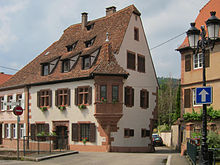L'ami Fritz
L'ami Fritz is a novel by the French team of writers Erckmann-Chatrian , which was published in 1863 as a newspapernoveland in 1864 for the first time in book form.
content

action
The novel is set in Hunebourg, a small town in the south of the Palatinate, in 1847. Fritz Kobus, son and heir of a justice of the peace, has lived as a wealthy bachelor for 15 years after his decision, without work and family, simply the life, the wine and the company of his friends in the Enjoy the “Zum Hirschen” ( Grand-Cerf ) economy . Despite the efforts of the rabbi ( rebbe ) David Sichel, who was his father's best friend and who regularly offers him the prettiest marriage candidates, Fritz has remained true to his approach to life.
Like every year at the beginning of spring, the gypsy ( bohémien ) visits Iôsef Fritz Kobus to play the violin to thank Fritz for saving him from the policeman Foux on Christmas day. Fritz invites Iôsef and some of his Hunebourg friends to a spring festival dinner, which old Katel knows how to prepare and which is accompanied by numerous bottles of the best wine that have accumulated over the years in the cellar of Fritz's father and grandfathers. Towards the end of this rich meal, the young Sûzel appears, the daughter of the Mennonite farmer Christel, who runs the Meisenthâl, the farm of the Kobus family. Fritz falls in love, but finds many reasons not to confess his love to Sûzel. Thanks to the rabbi's efforts, there is finally a wedding.
worldview
L'ami Fritz is the idyllic description of a small town that bears strong similarities to Erckmann's hometown Phalsbourg . Political and social tensions are not ignored (the residential area of the Jews is the poorest, peasants emigrate to America, the collection of taxes in a remote and poor village is described), but the main character of the novel seems to be above all these adversities of everyday life and just busy living well and maintaining his friendships. Fritz Kobus, whose biography and living conditions clearly resemble those of Erckmann, is a very tolerant person. Real role models can also be found in Erckmann's life for the other people.
The region between Landau and today's German-French border had belonged to France from the end of the so-called Reunion War (1683–1684) to the Congress of Vienna (1815). In their work Erckmann-Chatrian describe Fritz historically correctly as a subject of the King of Bavaria . The tax collector Hâan collects the taxes for the Kingdom of Bavaria , the Bavarian guilder is named as the currency .
reception
Chatrian initially unsuccessfully offered the novel to the Journal des Débats for publication in Paris . Finally, Auguste Nefftzer, the co-founder and editor of Le Temps , published the work to do his Alsatian compatriots a favor. L 'ami Fritz was then, to everyone's surprise, a great success.
The novel was also successfully published as a comedy in 3 acts by the authors in 1876 and has seen repeated editions in France until recently. It served as a template for the opera L'amico Fritz by Pietro Mascagni (1891) and was translated into German for Reclam's Universal Library in 1892 . In France, L'ami Fritz was filmed twice for the big screen (1920 and 1933) and twice for television (1967 and 2001).
In Marlenheim in Alsace ( Département Bas-Rhin ), scenes from the novel have been re-enacted every year since 1973 on August 14th and 15th as part of a folk festival.
literature
Text output
- Erckmann-Chatrian: L 'ami Fritz . Hachette, Paris 1864
- in Erckmann-Chatrian: Contes et romans populaires . Hetzel, Paris 1867
- in Erckmann-Chatrian: Gens d'Alsace et de Lorraine . Omnibus, Paris 2001. ISBN 2-258-03780-8
- Erckmann-Chatrian: L 'ami Fritz suivi de Myrtille . Edition Serpenoise, Metz 2004. ISBN 2-87692-627-X
- Émile Erckmann: friend Fritz. Narration . Reclam, Leipzig 1892 (Reclam's Universal Library 2945 / 2946a)
Secondary literature
- G. Benoit-Guyod: La vie et l'œuvre d'Erckmann-Chatrian pp. 13-270 in Jean-Jacques Pauvert (Ed.): Erckmann-Chatrian. Contes et romans nationaux et populaires , vol. XIV. Pauvert & Hachette, Paris 1962
Individual evidence
- ↑ G. Benoit-Guyod: La vie et l'œuvre d'Erckmann-Chatrian (pp. 113-114) in Jean-Jacques Pauvert (ed.): Erckmann-Chatrian. Contes et romans nationaux et populaires , vol. XIV. Pauvert & Hachette, Paris 1962
- ↑ G. Benoit-Guyod: La vie et l'oeuvre d'Erckmann-Chatrian (S. 114) in Jean-Jacques Pauvert (ed.): Erckmann-Chatrian. Contes et romans nationaux et populaires , vol. XIV. Pauvert & Hachette, Paris 1962
Web links
- German translation by Projekt Gutenberg: https://www.projekt-gutenberg.org/erckchat/amifritz/amifritz.html
- René Hervil (1921): L'ami Fritz in the Internet Movie Database (English)
- Jacques de Baroncelli (1933): L'ami Fritz in the Internet Movie Database (English)
- Georges Folgoas (TV; 1967): L'ami Fritz in the Internet Movie Database (English)
- Folk festival in Marlenheim: Le mariage de l'Ami Fritz (last checked on August 7, 2011)